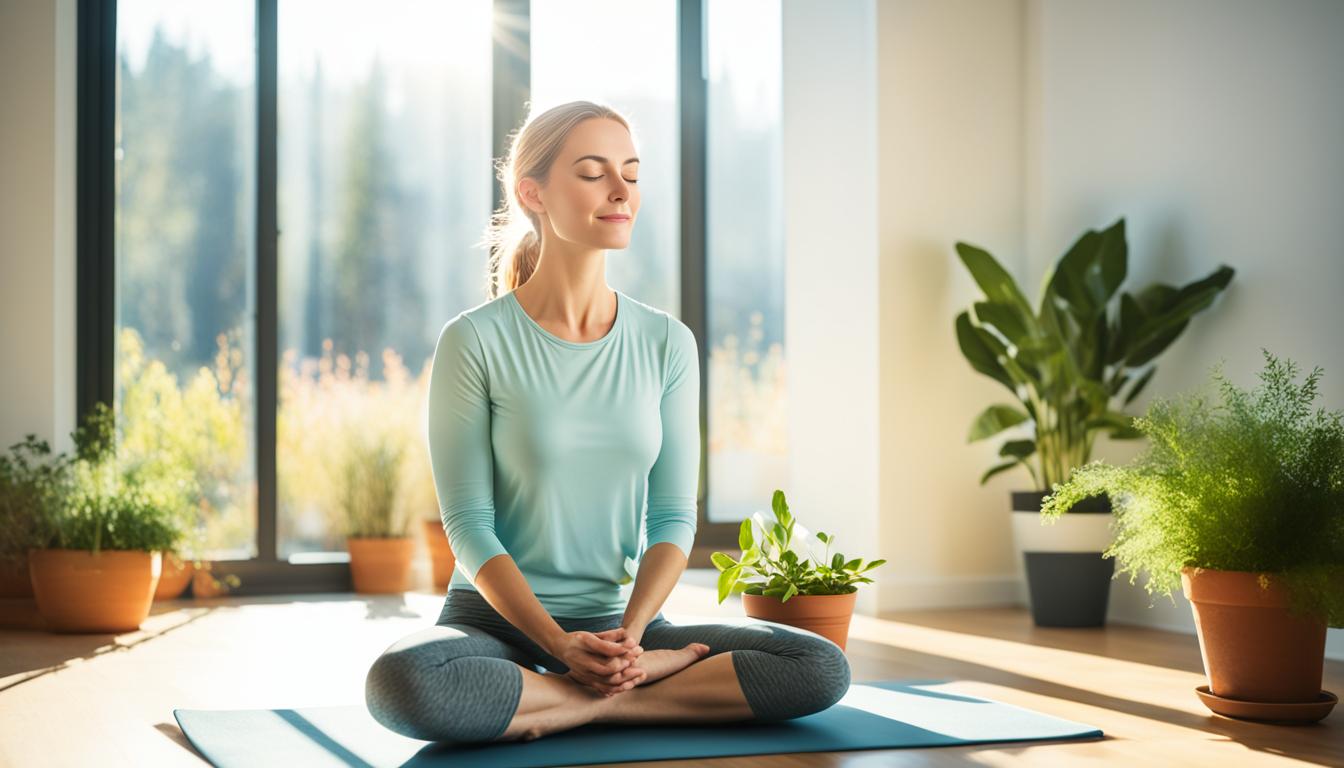In today’s fast-paced world, mindfulness meditation is a powerful tool for finding peace. It helps you unwind and cope with daily life’s chaos. By adding peaceful meditation techniques to your routine, you gain benefits like stress relief and better emotional health. This article will delve into mindfulness meditation’s essence, its various techniques, and its stress and anxiety reduction benefits. It draws from trusted sources like Calm and HelpGuide, aiming to help both beginners and seasoned practitioners achieve life balance.
Key Takeaways
- Meditation profoundly affects your mental state.
- Practicing gratitude can shift your focus to what you have, fostering inner peace.
- Connecting with nature instills a sense of peace and calm.
- Accepting uncertainties in life aids in creating inner peace.
- Non-judgment contributes to acceptance and peace within.
- Cultivating positive relationships enhances feelings of support and calm.
- Mindfulness meditation can improve your overall well-being and clarity.
Understanding Mindfulness Meditation
Mindfulness meditation is a practice that focuses on the present moment. It encourages you to observe your thoughts, feelings, and sensations without judgment. This approach helps you accept your current state, letting go of past regrets or future anxieties. Such acceptance leads to emotional balance and prepares you to face life’s challenges more effectively.
Many mindfulness meditation techniques are simple and can be integrated into your daily life. Even a few minutes of meditation each day can bring significant benefits. Research shows that regular practice improves both mental and physical health. Those who meditated had lower heart rates and better cardiovascular health than those who didn’t.
It also helps with sleep quality and is suggested for those struggling with sleep issues. Meditating three to four times a week can lead to noticeable improvements. An eight-week mindfulness course has been shown to boost immune function more than traditional treatments.
Embracing mindfulness can bring emotional clarity and inner peace. As you explore different meditation practices, consider adding mindfulness to everyday activities like brushing your teeth or driving. Making mindfulness a regular part of your life can lead to significant transformations, making your existence more present and fulfilling.
Benefits of Mindfulness Meditation
Practicing mindfulness meditation brings numerous advantages for both mental and physical health. Regular engagement in this practice yields significant benefits, such as stress reduction, enhanced emotional well-being, and improved cognitive function.
Reducing Stress and Anxiety
One of the primary benefits of mindfulness meditation is its effectiveness in reducing stress and anxiety. Studies indicate that mindfulness techniques can lower blood pressure and ease chronic pain. As meditation becomes a regular habit, you may notice an enhanced ability to handle life’s challenges, leading to increased happiness.
Improving Mental Clarity
Mindfulness meditation not only soothes the mind but also sharpens mental clarity. Regular practice is associated with better focus and concentration. You may discover that distractions have less influence on your ability to think clearly and effectively, which is advantageous in both personal and professional realms.
Enhancing Emotional Well-being
Another significant advantage of mindfulness is its impact on emotional well-being. It promotes self-acceptance and compassion, fostering healthier relationships with oneself and others. This practice encourages positive shifts in attitudes and behaviors, leading to a greater sense of peace and connection in everyday life.

How to Practice Mindfulness Meditation
Starting your mindfulness meditation journey is straightforward and fulfilling. You don’t need much preparation; just find a quiet spot and sit comfortably. Focus on your breath, letting thoughts come and go without judgment. Wondering how to practice mindfulness effectively? Begin with short sessions of five or ten minutes.
As you grow more adept, you can gradually extend your meditation time. Committing to it daily, even for a short period, is highly effective. Studies show that just 12 minutes of mindfulness, five days a week, can improve your focus.
For a better experience, follow mindfulness practice tips to integrate it into your daily life. Simple activities like brushing your teeth or eating lunch can become moments of mindfulness. Many people prefer meditating in the morning or evening, fitting it into their schedules.

Mindfulness meditation focuses on your breath or body sensations, serving as an anchor to reduce distractions. Consistently training your brain to be mindful can lead to changes in your physical brain structure. Jon Kabat-Zinn, the founder of Mindfulness-Based Stress Reduction, emphasizes the benefits of activating dormant brain areas.
Sticking with this practice helps you better understand your reactions, creating space between your immediate responses. Mindfulness can transform your relationship with stress and anxiety, leading to a more positive emotional state.
Mindfulness Techniques for Beginners
Embarking on the mindfulness journey can seem overwhelming, yet it’s surprisingly accessible with simple practices. Breathing exercises and body scan meditation are two foundational techniques for beginners. These practices foster relaxation and self-awareness, laying the groundwork for deeper meditation engagement.
Breathing Exercises
Breathing exercises are crucial in guided mindfulness meditation. They help you focus on your breath’s natural rhythm, leading to calm and present awareness. Start by inhaling deeply, allowing your chest and belly to expand fully. Then, exhale slowly, feeling any tension dissipate. This exercise not only aids in relaxation but also reconnects you with the present, paving the way to mindfulness.
Body Scan Meditation
Body scan meditation is a powerful technique for beginners. It involves mentally checking in with different body parts, noting any sensations, tension, or discomfort. As you move through your body, you might find areas with stress or tightness. Recognizing these sensations allows for tension release and invites deeper relaxation. Adding this technique to your routine can significantly improve your mindfulness practice.

Incorporating Mindfulness into Daily Life
Integrating mindfulness into daily life can revolutionize your routine. With about 95% of our actions on autopilot, most of our activities go unnoticed. Simple practices can disrupt this cycle, boosting awareness. Try pausing for a few minutes daily to refocus on the present.
Practicing mindfulness during activities like eating or walking aligns conscious thinking with emotional responses. This approach helps you become more aware of your emotional and physical states.
Starting your day with intentions improves communication and relationships. Being intentional during activities like eating ensures your choices align with your true needs. Mindful eating turns every meal into a mindful experience, promoting enjoyment and satisfaction.

Physical activities can also be infused with mindfulness. Whether cycling or lifting weights, fully engaging in these activities synchronizes your body and mind. This method enriches your workout, transforming your experience from feeling overwhelmed to feeling empowered.
When stress hits, mindfulness offers clarity and resilience, helping you see things in perspective. It shifts your focus from the immediate stress to a broader view.
In relationships, being present fosters more compassionate interactions. Mindfulness lets you observe without judgment, improving communication quality. Studies show that practicing gratitude and active listening boosts mental health and happiness. Regular mindfulness practice shifts your focus to positivity, enriching your daily life.
Mindfulness Meditation vs. Traditional Meditation
When comparing mindfulness meditation to traditional meditation, distinct differences emerge in their approaches and philosophies. Mindfulness meditation focuses on being fully present and non-judgmental, enhancing acceptance and attention to the current moment. Dr. Lagoy points out its accessibility, allowing practice anywhere, anytime.
Traditional meditation, on the other hand, often employs structured techniques like mantra repetition or guided visualization. Shelton notes the variety in meditation forms, including guided, movement-based, and visual ones. Despite their shared goals of mental clarity and emotional balance, the methods differ significantly.
The term meditation encompasses a wide array of practices aimed at enhancing mental clarity and emotional calm. John Kabat-Zinn defines mindfulness as “the awareness that arises through paying attention, on purpose, in the present moment, non-judgmentally.” This definition highlights mindfulness meditation’s active, present-focused nature.
Both mindfulness and traditional meditation have unique purposes and benefits. Mindfulness meditation is effective in combating persistent negative thoughts, as Dr. Lagoy explains. Programs like Mindfulness-Based Stress Reduction (MBSR) systematically develop mindfulness skills for daily life. Traditional practices, such as Transcendental Meditation, employ passive and exclusive methods, differing from mindfulness’s versatility and accessibility.

Effective Mindfulness Exercises
Exploring effective mindfulness exercises can significantly enhance your meditation journey. By integrating structured practices, you can deepen your experience and cultivate a stronger sense of peace. Two particularly beneficial methods are guided mindfulness meditation and walking meditation, both of which promote mindfulness and help you remain present.
Guided Mindfulness Meditation
Guided mindfulness meditation provides verbal instructions that help you focus your thoughts. This approach is particularly useful for newcomers seeking relaxation. Through visualization techniques, you create mental conditions that foster happier, healthier relationships. As you listen to the guidance, you’re encouraged to become aware of your surroundings, which enhances self-awareness and reflection. Consider trying out three-minute meditation for a quick and effective introduction to mindfulness exercises for peace.
Walking Meditation
Walking meditation blends movement with mindfulness, allowing you to connect with the rhythm of your steps. This practice encourages you to be present by focusing on the sensations of your feet touching the ground and the environment around you. As you walk, gently bring your attention back to the present moment, which can help improve your overall mood. Such effective mindfulness exercises require minimal effort and can be done anywhere, making it easier to incorporate them into your daily routine.
Using Mindfulness Apps
Mindfulness apps have transformed the way we practice meditation. Platforms like Headspace and Calm offer accessible tools for all levels of experience. Since 2018, Wirecutter has reviewed 19 apps, showing how they can improve your meditation practice.
Headspace features over 500 meditations, courses, and lectures, reaching 20 million users in 190 countries. Calm provides more than 100 meditations and courses, with a yearly subscription for individuals at $70 and for families at $100. It also has a special section for kids, featuring calming meditations and sleep aids.
These apps offer structured resources tailored to your needs. Within Calm, you can find six breathing exercises designed for different relaxation goals. Research shows that using these apps can boost mental health. Participants in Headspace experienced more positive emotions and less burden after just 100 minutes of practice.
Despite their popularity, the effectiveness of mindfulness apps versus face-to-face guidance is still debated. There’s limited research on their long-term effects, especially on user engagement. Many studies indicate that most users drop out within two weeks, yet interest in mindfulness remains strong.
Even without extensive scientific testing, these apps have shown promise in promoting mindfulness and easing mental health symptoms. Using these apps can be a practical and effective way to incorporate mindfulness into your daily life.
Overcoming Common Challenges in Mindfulness Meditation
Many individuals face meditation obstacles when beginning their mindfulness journey. With determination, these hurdles can be surmounted, enhancing the practice. A common issue is a busy mind, prone to drifting into past or future thoughts. Techniques focusing on breath awareness can redirect your focus, training your brain to enhance concentration.
Physical discomfort is another challenge. It’s vital to find a sitting position that supports focus and relaxation. If discomfort persists, trying different postures or times for your practice might improve your alertness and comfort.
Boredom or frustration in meditation is not uncommon. Acknowledge these feelings without judgment; curiosity about your mental states can deepen your practice. Each emotion offers a chance for personal growth, crucial in overcoming mindfulness challenges.

External distractions can challenge your mindfulness commitment. To counter this, choose a quiet space for your practice and accept any disturbances as learning opportunities. This approach transforms obstacles into moments of growth and reflection.
Understanding the mind-body connection reveals how thoughts and emotions influence your physical state during meditation. Observing your thoughts without attachment helps you manage challenges like desire, anger, and drowsiness. Imagining a clear pond can aid in overcoming these obstacles, keeping your mindfulness journey engaged and fruitful.
Mindfulness Meditation for Stress Relief
Mindfulness meditation is a potent tool against stress. Chronic stress can alter the body’s chemistry, raising blood pressure, heart rate, and blood sugar levels. Mindfulness offers a way to foster calm and acceptance in the face of life’s hurdles.
Practices like mindful breathing and visualization serve as stress relief techniques. They create a mental “pause button” for better stress response. A study in the Journal of Research in Personality found that present-moment awareness boosts stress resilience and coping skills. This awareness enhances your ability to tackle stressful situations with confidence.
Integrating these practices into your daily life can yield significant benefits. The Centers for Disease Control note that many American workers suffer from sleep issues due to stress. Mindfulness can help reduce stress and support your health.
Studies reveal that mindful breathing activates the parasympathetic nervous system. This leads to lower heart rate and blood pressure. These changes are vital for your body’s healing, offering deep relief from anxiety and tension. Mindfulness also improves your ability to handle negative thoughts and emotions, enhancing your stress management.
Exploring Different Types of Mindfulness Meditation
Mindfulness meditation includes a range of styles, each with distinct benefits and experiences. These styles allow you to discover the one that aligns with your personal path.
Loving-Kindness Meditation
Loving-kindness meditation, or Metta meditation, aims at developing love and compassion for oneself and others. It involves sending positive thoughts to friends, family, and even those you may have conflicts with. This practice enhances empathy and warmth, deepening connections with others.
A recent study showed that deep breathing during this meditation boosts feelings of benevolence. This reinforces positive emotions with consistent practice.
Transcendental Meditation
Transcendental meditation involves repeating a mantra for twenty minutes, twice daily. It promotes relaxation and helps achieve inner peace. Research suggests it can reduce stress, burnout, and depression, while improving overall well-being.
Many find these short sessions enhance mental clarity and emotional stability. This leads to more productive daily life.
Other meditation styles, like Vipassana and chakra meditation, also aid in your mindfulness journey. Each style offers a unique path to self-understanding and emotional balance. You can explore more about these methods and their benefits at unique styles and benefits.
Creating a Mindfulness Meditation Space at Home
Setting up a dedicated meditation space can profoundly improve your practice. Begin by selecting a quiet area in your home, ensuring it’s free from interruptions. Creating a calm mindfulness environment starts with soft, natural lighting, which fosters a serene atmosphere ideal for meditation.
Comfort is crucial for effective meditation. Include items like cushions or soft rugs, often found in successful meditation areas. Ethel Studio meditation cushions, for instance, offer the necessary comfort for extended mindfulness sessions. Personalizing your space with calming decor, plants, or artwork can also enhance relaxation and make it uniquely yours.
Essential oils or incense can intensify your meditative state. Many people report that these scents aid in entering a meditative state more swiftly. Designating a specific area for meditation promotes a routine, simplifying the maintenance of your practice.
Integrating natural elements or personal items, such as vintage pieces or colorful rugs, can reflect your personality and preferences. About 40% of meditation spaces benefit from such personal touches, strengthening your connection to the practice.
Many practitioners meditate more effectively in a warm, comfortable setting. Statistics indicate that around 60% of meditation spaces prefer light color schemes, while about 10% are located outdoors. Incorporating nature can significantly enhance your mindfulness experience.
Regular visits to your meditation space at set times, like morning or after work, can reinforce your routine. You might also consider setting up a meditation space for your children, promoting self-soothing skills and emotional well-being.
Embark on this journey with what you already possess. Utilizing existing items can spark creativity in setting up your meditation space. By reserving a corner in your home for mindfulness, you can enhance your practice and reap the numerous benefits meditation provides.
Conclusion
Mindfulness meditation is a potent tool for boosting your well-being. It offers a path to inner peace, stress reduction, and emotional clarity. This summary has shown how to incorporate various techniques into daily life for significant benefits. These practices enhance mental clarity and emotional resilience, changing how you see the world.
Research confirms mindfulness meditation’s effectiveness, showing it rivals standard treatments for anxiety. Over an 8-week period, participants saw a marked decrease in anxiety. This underscores mindfulness’s role in improving emotional health. Better sleep quality among meditators further highlights the holistic benefits of these practices.
Whether you’re just starting or have been meditating for years, the time spent practicing can deeply impact your self-awareness and outlook. Mindfulness is more than brief relaxation; it’s about building lasting peace and resilience. Embrace the deep tranquility and insights that mindfulness meditation brings as you delve deeper into its benefits.
FAQ
What is mindfulness meditation?
How can mindfulness meditation help with stress relief?
What are some simple mindfulness techniques I can start with?
Are there apps available for mindfulness meditation?
Can mindfulness meditation be practiced anywhere?
What types of mindfulness meditation are there?
How long should I meditate each day as a beginner?
What should I do if I encounter challenges during my mindfulness practice?
How can I create a calming environment for my mindfulness meditation?
Can mindfulness meditation help improve my mental clarity?
Source Links
- 12 essential mindfulness practices for cultivating inner peace — Calm Blog – https://www.calm.com/blog/inner-peace
- 2bpresent – Mindfulness Meditation – https://www.2bpresent.com/
- Mindfulness & Meditation – Harvard University – https://www.harvard.edu/in-focus/mindfulness-meditation/
- Learn How to Make a Mindfulness Meditation Practice Part of Your Day – https://www.verywellmind.com/mindfulness-meditation-88369
- Can mindfulness exercises help me? – https://www.mayoclinic.org/healthy-lifestyle/consumer-health/in-depth/mindfulness-exercises/art-20046356
- Benefits of Mindfulness – HelpGuide.org – https://www.helpguide.org/harvard/benefits-of-mindfulness.htm
- The Science of Mindfulness – https://www.mindful.org/the-science-of-mindfulness/
- What are the benefits of mindfulness? – https://www.apa.org/monitor/2012/07-08/ce-corner
- Mindfulness Meditation: How to Do It – https://www.mindful.org/mindfulness-how-to-do-it/
- Getting Started with Mindfulness – https://www.mindful.org/meditation/mindfulness-getting-started/
- How to Meditate – https://www.mindful.org/how-to-meditate/
- 21 Mindfulness Exercises & Activities For Adults (+ PDF) – https://positivepsychology.com/mindfulness-exercises-techniques-activities/
- 5 Simple Mindfulness Practices for Daily Life – https://www.mindful.org/take-a-mindful-moment-5-simple-practices-for-daily-life/
- How to Make Mindfulness Your Way of Life – https://www.verywellmind.com/mindfulness-exercises-for-everyday-life-3145187
- 10 Simple Ways to Practice Mindfulness In Our Daily Life – https://moniquetallon.com/10-simple-ways-to-practice-mindfulness-in-our-daily-life/
- Mindfulness vs. Meditation: What’s The Difference? – https://www.forbes.com/health/mind/mindfulness-vs-meditation/
- 5 Differences Between Mindfulness and Meditation – https://positivepsychology.com/differences-between-mindfulness-meditation/
- Mindfulness vs Meditation: What’s the Difference? – https://www.verywellmind.com/mindfulness-vs-meditation-what-s-the-difference-6822721
- Mindfulness Exercises – Free Meditations for Mindfulness Exercises and Guided Meditations – https://mindfulnessexercises.com/
- Meditation and Mindfulness Exercises – Headspace – https://www.headspace.com/meditation/exercises
- 7 Ways to Be More Mindful Without Meditating – https://www.self.com/story/best-mindfulness-exercises
- The Best Meditation Apps – https://www.nytimes.com/wirecutter/reviews/best-meditation-apps/
- How Do Mindfulness Apps Work? – https://www.mindful.org/how-do-mindfulness-apps-work/
- The impact of mindfulness apps on psychological processes of change: a systematic review – npj Mental Health Research – https://www.nature.com/articles/s44184-023-00048-5
- How To Overcome Top 10 Obstacles in Mindfulness Practice – https://www.dummies.com/article/body-mind-spirit/emotional-health-psychology/emotional-health/mindfulness/top-10-difficulties-in-mindfulness-practice-and-how-to-overcome-them-144294/
- Overcome These Five Common Obstacles to Meditation – https://www.mindful.org/overcome-these-five-common-obstacles-to-meditation/
- How to Manage Stress with Mindfulness and Meditation – https://www.mindful.org/how-to-manage-stress-with-mindfulness-and-meditation/
- Mindfulness meditation: A research-proven way to reduce stress – https://www.apa.org/topics/mindfulness/meditation
- A Guide to 7 Different Types of Meditation – https://www.everydayhealth.com/meditation/types/
- Eight types of meditation: What type is best for you? – https://www.medicalnewstoday.com/articles/320392
- Creating the Perfect Meditation Space – https://balanceapp.com/blog/crafting-your-ideal-meditation-space
- 10 Meditation Spaces That Will Inspire You to Create Your Own – https://www.thespruce.com/meditation-spaces-that-inspire-4177495
- How To Create A Small Space Meditation Corner – https://www.thegoodtrade.com/features/meditation-room-ideas/
- Mindfulness and Meditation at SweatHouz – https://www.sweathouz.com/mindfulness-meditation-at-sweathouz/
- Effects of mindfulness meditation on mindfulness, mental well-being, and perceived stress – https://www.sciencedirect.com/science/article/abs/pii/S1877129718304568


